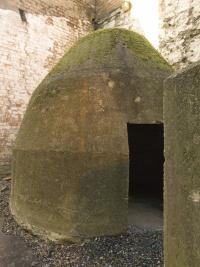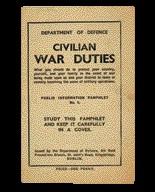Beehive bomb shelter
Published in 20th-century / Contemporary History, Features, Issue 2(March/April 2012), The Emergency, Volume 20
The ‘beehive’ shelter—it had walls 32cm thick, a 2m-high ceiling and could accommodate up to six people.
In 1939, as World War II approached, countries looking at what had happened in the Spanish Civil War prepared for a new form of warfare—attack on civilians from the air. In preparation for this the Irish government purchased 300,000 gasmasks, and a ‘beehive’ shelter was designed by the Irish Defence Forces to resist the blast of a 500lb bomb.The shelter was igloo-shaped and looked like a monastic beehive hut but made of mass concrete. It had walls 32cm thick, a 2m-high ceiling and could accommodate up to six people. During the Emergency beehive shelters were built behind public buildings, with priority given to Dublin and Dún Laoghaire corporations, and later towns along the south and east coast. For those who could afford the £10–10s it cost to build, the Department of Defence provided a pamphlet entitled Civilian war duties, which included drawings of the shelter, and some were built in back gardens in the suburbs of south Dublin. A public test in Kilbride military camp, Co. Wicklow, on 10 June 1939 revealed that the shelter could protect its occupants from a 500lb bomb exploding as little as 10m away. To prove the shock-absorbing power of the shelter, the then minister for defence, Frank Aiken, sat inside the shelter with members of the air-raid protection department while army engineers exploded a bomb outside. As the newspapers reported afterwards, when he came outside he was asked by Seán Lemass, minister for industry and commerce, ‘Well, any sensation?’ and replied, ‘None at all, no blast or shock’. Although the beehive shelter proved effective, it did require a large amount of concrete and was never built in large numbers. Those behind public buildings were of limited use, as they could only hold six people—and 70 years later it would be interesting to know who were the six people nominated to go into the shelter and who was to be left outside. If you have photographs of a beehive shelter in your back garden, please send them to ljoye@museum.ie. HI

Civilian war duties—this Department of Defence pamphlet included drawings of the shelter for those who could afford the £10–10s. it cost to build.
(All images: National Museum of Ireland)
Lar Joye is curator of military history at the National Museum of Ireland (Decorative Arts and History).
















